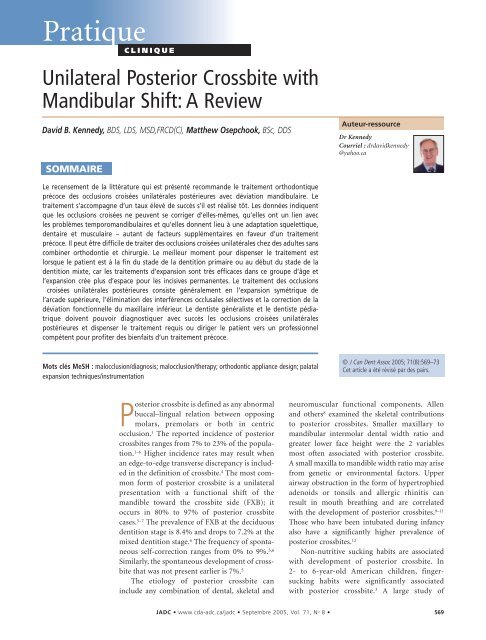JADC - Canadian Dental Association
JADC - Canadian Dental Association
JADC - Canadian Dental Association
You also want an ePaper? Increase the reach of your titles
YUMPU automatically turns print PDFs into web optimized ePapers that Google loves.
Pratique<br />
CLINIQUE<br />
Unilateral Posterior Crossbite with<br />
Mandibular Shift: A Review<br />
David B. Kennedy, BDS, LDS, MSD,FRCD(C), Matthew Osepchook, BSc, DDS<br />
SOMMAIRE<br />
Le recensement de la littérature qui est présenté recommande le traitement orthodontique<br />
précoce des occlusions croisées unilatérales postérieures avec déviation mandibulaire. Le<br />
traitement s’accompagne d’un taux élevé de succès s’il est réalisé tôt. Les données indiquent<br />
que les occlusions croisées ne peuvent se corriger d’elles-mêmes, qu’elles ont un lien avec<br />
les problèmes temporomandibulaires et qu’elles donnent lieu à une adaptation squelettique,<br />
dentaire et musculaire – autant de facteurs supplémentaires en faveur d’un traitement<br />
précoce. Il peut être difficile de traiter des occlusions croisées unilatérales chez des adultes sans<br />
combiner orthodontie et chirurgie. Le meilleur moment pour dispenser le traitement est<br />
lorsque le patient est à la fin du stade de la dentition primaire ou au début du stade de la<br />
dentition mixte, car les traitements d’expansion sont très efficaces dans ce groupe d’âge et<br />
l’expansion crée plus d’espace pour les incisives permanentes. Le traitement des occlusions<br />
croisées unilatérales postérieures consiste généralement en l’expansion symétrique de<br />
l’arcade supérieure, l’élimination des interférences occlusales sélectives et la correction de la<br />
déviation fonctionnelle du maxillaire inférieur. Le dentiste généraliste et le dentiste pédiatrique<br />
doivent pouvoir diagnostiquer avec succès les occlusions croisées unilatérales<br />
postérieures et dispenser le traitement requis ou diriger le patient vers un professionnel<br />
compétent pour profiter des bienfaits d’un traitement précoce.<br />
Mots clés MeSH : malocclusion/diagnosis; malocclusion/therapy; orthodontic appliance design; palatal<br />
expansion techniques/instrumentation<br />
Posterior crossbite is defined as any abnormal<br />
buccal–lingual relation between opposing<br />
molars, premolars or both in centric<br />
occlusion. 1 The reported incidence of posterior<br />
crossbites ranges from 7% to 23% of the population.<br />
1–6 Higher incidence rates may result when<br />
an edge-to-edge transverse discrepancy is included<br />
in the definition of crossbite. 4 The most common<br />
form of posterior crossbite is a unilateral<br />
presentation with a functional shift of the<br />
mandible toward the crossbite side (FXB); it<br />
occurs in 80% to 97% of posterior crossbite<br />
cases. 5–7 The prevalence of FXB at the deciduous<br />
dentition stage is 8.4% and drops to 7.2% at the<br />
mixed dentition stage. 6 The frequency of spontaneous<br />
self-correction ranges from 0% to 9%. 5,6<br />
Similarly, the spontaneous development of crossbite<br />
that was not present earlier is 7%. 5<br />
The etiology of posterior crossbite can<br />
include any combination of dental, skeletal and<br />
Auteur-ressource<br />
Dr Kennedy<br />
Courriel : drdavidkennedy<br />
@yahoo.ca<br />
© J Can Dent Assoc 2005; 71(8):569–73<br />
Cet article a été révisé par des pairs.<br />
neuromuscular functional components. Allen<br />
and others 8 examined the skeletal contributions<br />
to posterior crossbites. Smaller maxillary to<br />
mandibular intermolar dental width ratio and<br />
greater lower face height were the 2 variables<br />
most often associated with posterior crossbite.<br />
A small maxilla to mandible width ratio may arise<br />
from genetic or environmental factors. Upper<br />
airway obstruction in the form of hypertrophied<br />
adenoids or tonsils and allergic rhinitis can<br />
result in mouth breathing and are correlated<br />
with the development of posterior crossbites. 9–11<br />
Those who have been intubated during infancy<br />
also have a significantly higher prevalence of<br />
posterior crossbites. 12<br />
Non-nutritive sucking habits are associated<br />
with development of posterior crossbite. In<br />
2- to 6-year-old American children, fingersucking<br />
habits were significantly associated<br />
with posterior crossbite. 3 A large study of<br />
<strong>JADC</strong> • www.cda-adc.ca/jadc • Septembre 2005, Vol. 71, N o 8 • 569
















